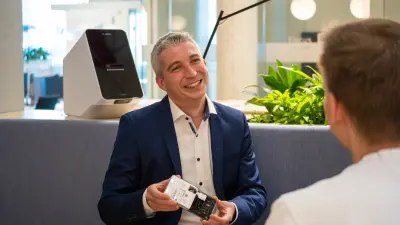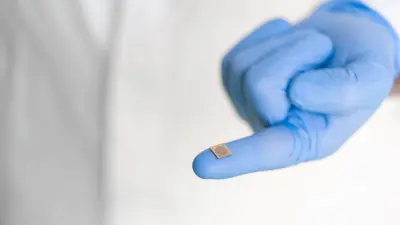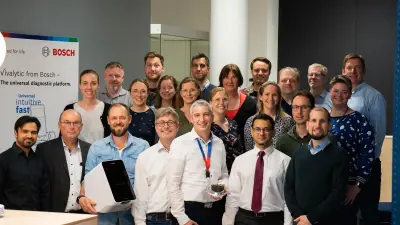BioMEMS — or why completing your PhD at Bosch Research pays off
An interview with Dr. Daniel Podbiel, research engineer at Bosch Research

Speed is of the essence when it comes to determining the causes of illness and identifying pathogens. That’s why Bosch focuses directly on the point-of-care with its laboratory diagnostic platform Vivalytic. As a result, tests no longer need to be sent to the laboratory, but can be evaluated directly on site. Now the Vivalytic test procedures are to be expanded by a new BioMEMS technology.

Just recently Bosch announced partnerships with Randox Laboratories Ltd. and R-Biopharm, as part of which we will invest 150 million euros each in joint research, development, and sales activities for new tests on the Vivalytic laboratory diagnostic platform. Attention is focused on high-multiplex tests for detecting the cause of sepsis, in which a large number of pathogens can be detected simultaneously using a real-time PCR test, as well as on tests for detecting multiresistant bacteria. This is possible thanks to a novel BioMEMS technology, which was developed by teams from Bosch Research in Renningen and Bosch Healthcare Solutions (BHCS) in Waiblingen. The development involves combining technology from the field of microelectromechanical systems (MEMS) with microfluidics (movement of small quantities of fluid in the smallest of spaces).
Daniel Podbiel laid the groundwork for this technology as part of his PhD at Bosch Research in the Advanced Technologies and Micro Systems department. An exciting matter we felt, so we decided to speak to Daniel about the technology, his time on Bosch’s PhD program, and the importance of his research.
Editorial team: Hello Daniel, can you explain the technology in its basic principles?
Daniel Podbiel: BioMEMS technology, or more precisely PCR array technology, enables a completely new implementation of analysis procedures in the Vivalytic test cartridge. On the chip, therefore, we can test a sample for up to 250 genetic characteristics simultaneously and automatically by means of parallel real-time PCR analyses. This can be done in under 15 minutes and directly where the sample is taken. In the case of medical conditions where the pathogen needs to be identified as quickly as possible, such as with sepsis, BioMEMS technology can help to save lives.
Editorial team: What is new about the technology?
Daniel: What is groundbreaking about this innovation is that we were able to transfer technology from the field of microelectromechanical systems (MEMS), which is already established in the sensor world at Bosch, to healthcare and specifically to the field of point-of-care diagnostics. This allows us to perform complex molecular diagnostic tests compactly in a decentralized system. We have reimagined the silicon chip for this purpose and converted it into a microfluidic chip. This means we have adapted the wetting properties of the chip surface appropriately and carried out suitable microstructuring that ensures a specific interaction with the fluids. This allows us to implement completely new microfluidic functionalities on the nanoliter scale.
The ability of Bosch Research to think outside the box is a particular strength in this respect. We often succeed in using fundamental technologies for new areas of application and domains. One of the reasons why this is so effective is our interdisciplinary way of working at Bosch Research. Another facilitating factor is that laboratories are located within close reach of each other at the Renningen site. In this way we have also achieved such a technology transfer here: from microelectromechanical systems to biochemical applications in the field of laboratory diagnostics.

Editorial team: What are the advantages of the new “hardware”, the silicon chip?
Daniel: We use silicon because its high thermal conductivity allows a polymerase chain reaction, i.e. PCR, to be carried out particularly quickly. In addition, silicon can be microstructured particularly precisely using processes established in microsystems technology, thus allowing a new level of miniaturization to be achieved in the area of point-of-care diagnostics. As a result, we can significantly increase the degree of parallelization with which the assay reactions can be carried out in the cartridge for test purposes. The degree of parallelization in this context means the number of pathogens that can be detected in parallel.
Different pathogens can be a decisive factor in the case of sepsis, for example, but at the same time, action must be taken quickly and correctly. Such a technology is invaluable in this respect, because it can be implemented decentrally in a compact analyzer and allows extremely fast and precise identification of the relevant pathogen from a large number of possible causes as well as any potential antibiotic resistance of individual pathogens.
Editorial team: What impact did your PhD thesis have on the project?
Daniel: The Vivalytic laboratory diagnostic platform already existed — incidentally it was also invented by Bosch Research — but the number of pathogens that could be detected in parallel by means of real-time PCR was limited to a maximum of ten. The aim of my PhD thesis was to develop a technology that would allow this number to be increased significantly. A laboratory standard for large-volume, classic tests, for example, would be 96 reaction vessels. We wanted to achieve this degree of parallelization on a small scale — within our lab-on-chip system.
Editorial team: And how did you achieve that?
Daniel: The first part of the work involved basic research in the field of microfluidics, which was to serve as the basis for developing a prototype. The silicon chip in itself was easy to implement thanks to the established MEMS technology at Bosch. The major difficulty involved functionalizing the chip properly and ensuring its microfluidic integration into the overall system. The final step was to determine how the fluids were to be guided so that the system would function reliably.
This BioMEMS technology was transferred to the Bosch Healthcare Solutions division last year, with responsibility for developing and producing the BioMEMS chip resting with the Mobility Electronics (ME) division. Our BHCS colleagues have been working at full tilt to further develop the technology to market maturity and to find suitable partners for efficient market implementation. BHCS has now found such suitable partners in Randox Laboratories and R-Biopharm.

Editorial team: How did Bosch’s PhD program support you in your research?
Daniel: The working environment was a great help along with the Bosch Research site in Renningen, where so many disciplines come together. In the PhD program, the active interdisciplinary exchange with other doctoral students, for example at the annual PhD conference and joint events, was very valuable. This also applies to the great support from the department and my supervisor Jochen Hoffmann. But I would like to make special mention of the site in how it instilled confidence from the outset that great things can be achieved. The technical opportunities are provided here to break new ground and to bring together various aspects that no one had ever thought of or done before!
Editorial team: Do you have advice for current and future PhD students so that their research results can also have real-world applications?
Daniel: Never give up on your visions and goals even if it isn’t always easy or there is a risk of losing sight of the end point. Try to overcome limitations and allow your enthusiasm to guide you. It’s important to have collaborators, because by working together you can reach your goal faster.

Editorial team: What does it feel like when your PhD thesis becomes the basis for a technology that will revolutionize the market and can help save lives?
Daniel: It’s obviously a great feeling. One of my main reasons for applying to Bosch was the opportunity to develop technology that is “invented for life”. I know that claims do not always deliver what they promise — but they do at Bosch: I experience time and again that we are working on products that make people’s lives better. That has been an excellent motivation for me so far. On the one hand, I am grateful for everything that’s behind me — for the eventful times, the general environment, for the amazing role models and colleagues I have here, who continue to strengthen me. But I’m looking to the future too and realize that there is still so much to develop in the area of Healthcare Solutions. In short: We don’t have time to rest on our laurels, rather must move forward with determination. The principal aim of our work is to make these systems cost-effective and widely available so that, for example, we can also bring them to developing countries in order to raise medical standards there. The motivation to develop technology “invented for life” therefore remains my driving force.
Editorial team: Was it therefore always an important incentive for you that your research would benefit the wider community?
Daniel: Absolutely, and also that it is product-related. That’s why after my master’s degree I knew that I would take the step from basic university research to industrial development. I am delighted that in Bosch I have found a company that offers such exceptional opportunities at a research and development site like Renningen.